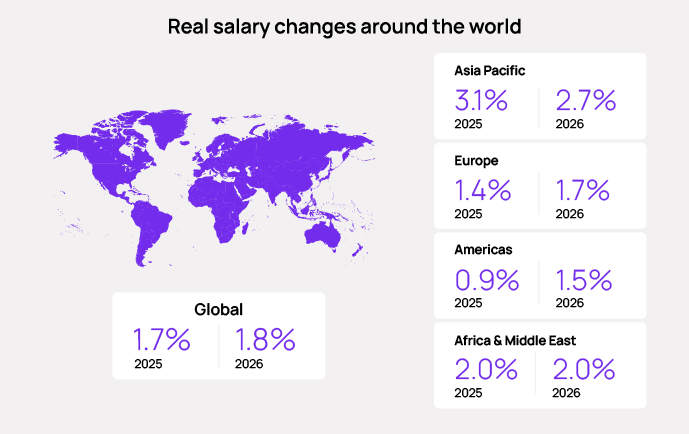Global real wage growth remains stable as inflation continues to fall. This brings a welcome sense of stability after the turbulence of the pandemic years and the inflation spikes that followed Russia’s invasion of Ukraine. ECA’s latest Salary Trends Survey reveals an increase in salaries of 1.7% above inflation for 2025, continuing the return to positive growth seen last year. The good news is set to continue, with an increase of 1.8% forecast for 2026, marking a third consecutive year of real wage rises.

Real pay rises ticking higher than pre-pandemic
Real-terms salary increases are calculated by taking the salary increase awarded to employees by their employers (the nominal increase) and subtracting the rate of inflation. Real rises in 2025 were slightly lower than had been forecast given that inflation was higher than expected. However, with inflation again expected to fall in 2026, real salaries are forecast to rise upwards to 1.8%. 91% of countries surveyed are predicted to see real salary rises next year, compared to 82% who did so in 2025.
With global average nominal salary increases predicted to remain at 4.7% in 2026, and inflation on the way down, it seems that real increases have stabilised in a higher position than before the pandemic – global real wage increases were 1.4% in 2019. It will be interesting to see if this is a sustained long-term trend or if it is simply a case of slowly clawing back the losses seen in the early part of the decade.
Regional variations
While the overall picture is a broadly positive one, local staff in some regions fare better than in others. Asia-Pacific forged ahead in 2025, with a real increase of 3.1%, the only region to break 3%, and a full 1.1% higher than the next best performing region (Africa and Middle East). Emerging economies in the region, such as Pakistan, Sri Lanka and India have done particularly well, sitting in first, second and third place globally. Inflation coming in at under 2% for 2025 in the region goes a long way to explaining this pattern, which was 0.5% lower than predicted last year.
In 2026, Asia-Pacific is once again expected to lead the way. However, it is also the only region where the above-inflation increase will be lower next year than in 2025. While nominal wage growth will remain robust, inflation is forecast to pick up in many Asian economies - such as India, Indonesia, and the Philippines - eroding some of those real gains. Still, seven countries from the region are predicted to rank among the top 10 worldwide, underpinned by rapid productivity gains, ongoing competition for skilled labour and policy efforts to raise living standards.
After a difficult year for local wages in Europe the outlook is brighter for 2026. Real pay is expected to rise by 1.7%, up from a disappointing 1.4% in 2025, which was 0.3% below the forecast. This year’s shortfall largely reflects stubbornly high inflation, which ran about half a percentage point above expectations, partly driven by persistent food price pressures. Encouragingly, inflation is projected to ease to around 2.3% in 2026, paving the way for modest but meaningful real income gains even as nominal salary growth looks set to be lower than in 2025. Indeed, only Romania is expected to see a negative change in real wages in 2026.
However, there are differences even within the region. Eastern European economies are generally forecast to outperform their Western European peers once again, benefiting from faster economic growth and higher productivity. Hungary is the standout, predicted to deliver a 3.5% real wage increase, actually placing it among the global top 10 for 2026. By contrast, major Western European economies such as the UK, Spain, and the Netherlands will continue to lag behind the regional average. Despite easing inflation, these countries are still grappling with issues such as sluggish productivity growth, tight fiscal conditions and employers’ caution about long-term pay commitments.
In the United States, real salaries for local staff rose by 0.8% in 2025, a full percentage point below forecasts, as inflation proved more stubborn than expected. This may be partly due to the inflationary impact of trade tariffs introduced under the Trump administration in 2025 which have pushed up the cost of imported goods and materials, adding to consumer prices and eroding real pay gains. However, the picture for 2026 is slightly more positive. While nominal salaries are expected to remain at 3.5%, inflation is projected to ease from 2.7% to 2.4%, allowing real wage growth to edge up to 1.1%.
Looking ahead
Global wage forecasts for 2026 remain broadly positive. The chart below illustrates how real wages are stabilising to pre-pandemic levels. Interestingly the outlook for 2026 is for regional increases to converge, with Asia-Pacific pointing downwards and wages in other regions moving in the opposite direction:

Of course, unforeseen factors could still reshape the outlook. The rapid spread of AI was not widely predicted several years ago but has the potential to further disrupt labour markets. Demand for AI specialist roles has risen sharply but other jobs face slower pay progression or restructuring pressures. This shift could partly dampen overall wage growth even as it drives up salaries for those with AI expertise.
At the same time, further US tariffs and trade tensions may drive-up import costs again, keeping inflation higher than expected. Renewed hostilities in the Middle East could also spark inflationary pressure through higher oil prices. Building flexibility into salary planning and staying alert to shifting pressures will be key to managing 2026’s unpredictable pay landscape.
Strengthen your pay planning for 2026
Get in touch to find out how to access our 2025-26 Salary Trends report and explore actual and anticipated pay rises, local inflation levels, and visual tools that reveal the true picture of real wage growth.
You can also watch our recent webinar for expert commentary and a guided walkthrough of the headline findings.